|
KOREAN KANHWA SŎN BUDDHISM -- SPECIAL REPORT
|
|

Top Menu
Introduction
|

Architecture
25 Photos
|

Creatures
42 Photos
|

Deities
 59 Photos 59 Photos
|

Doors
13 Photos
|

Paintings
64 Photos
|

People
32 Photos
|

Votive Icons
21 Photos
|
|
Also See

|
Korean Influence on Early Japanese Buddhism. Not a systematic study, but rather a "sketch" of the key contributions of Korean monks, artisans, and specialists to early Japanese Buddhist doctrine, art, and architecture. 30 Photos.
|
|
DEITIES IN KOREA'S RELIGIOUS TRADITIONS. East Asian Buddhism (China, Korea, Japan) originated in India around 500 BC. Buddhism was introduced first to China via India and SE Asia in the 1st and 2nd centuries CE, then came to Korea via China / Central Asia in the 4th century, and finally arrived in Japan via Korea in the mid-6th century. But the meditative practices of the Chan/Seon/Zen traditions came much later. Chan 禪 emerged in China with Bodhidharma (C = Dámó 達磨, K = Talma 달마, J = Daruma 達磨) around the fifth or sixth century AD. Not until the 9th century did Chan begin to flourish in Korea at the so-called Nine Mountain Schools of Korean Seon 禪門九山. In Japan, where it is known as Zen 禪, it began to bloom during the Kamakura period (1185-1333). Despite the many indigenous / autochthonous deities found in each nation, all three countries share a common "core" of Buddhist deities, creatures, and lore. This photo gallery presents some of the most common deities found in Korea today -- most are found in China and Japan as well. Detailed annotations of the photos are presented below the slide show.
|
|
|
|
|
|
|
|
|
|
|
|
|
PHOTO CREDITS. All photos by Mark Schumacher (unless stated otherwise). Taken during a conference, meditation retreat, and tour related to Kanhwa Sŏn 看話禪 and Hwadu 話頭 meditative techniques (the Korean counterpart of Zen Kōan meditation). The event took place in Korea between June 23 and July 3, 2012. It was organized by the Center for the Study of the Chogye Order (Chonghak Yŏn'guwŏn) at Dongguk University. Participants included advanced graduate students, professors, and independent scholars in Korean Religions and Buddhist Studies. The retreat was held at Magoksa Temple, a few hours south of Seoul. If you would like to submit your own photo(s) for inclusion here (with credits to you), please contact me. If you have a Facebook account, you can also post your photos at the Korea Kanhwa Sŏn Facebook Group Page.
|
|
|
|
|
|
|
|
|
|
|
Shakamuni (Historical Buddha) and His Disciples (the Arhats)
|
|
|
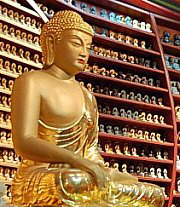
International Seon Center
Dongguk University, Seoul, Korea
|
|
Not surprisingly, Korean temples often enshrine an image of Śākyamuni, the Historical Buddha (C = Shìjiāmóuní 釋迦文尼, K = Sŏkga 석가, J = Shaka Nyorai). Many temples enshrine both Śākyamuni and statues of his first disciples, the Arhat or Rakan (C = āluóhàn 阿羅漢, K = arahan 아라한, J = arakan). Buddhism originated in Northern India, or present-day Nepal. It was here that the Historical Buddha (Prince Siddhartha, later Gautama Buddha), was born and lived in the sixth century BC. In China, his contemporaries were Confucius and Lao-tzu (the founder and "old boy" of Chinese Taoism), and slightly later in the West comes Plato (approx. 427 - 347 BC).
LEARN MORE
|
|
|
|
|
|
|
|
|
|
|
Vairocana or Mahāvairocana
|
|
|
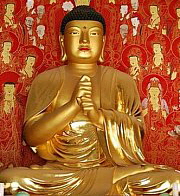
Vairocana, Bongamsa Temple
|
|
C = Dàrì 大日, K = Daeil 대일, J = Dainichi).
The Cosmic Buddha, Great Buddha, All-Encompassing Buddha. Central deity of the tantric or esoteric schools of Buddhism, who consider him the embodiment of light, the light of the universe. Central deity among the Five Buddha of Wisdom (Five Tathagata); represents center or zenith.
Says Louis Frederic in Flammarion Iconographic Guides: "The early sculptural style of Korea adhered closely to the Chinese models, but the Koreans were more enamored by the divinities from the estoric schools, and the images they produced strongly influenced the Japanese tradition."
LEARN MORE
Dainichi (A-to-Z Dictionary) |
|
|
|
|
|
|
|
|
|
|
Three Korean Spirits
|
|
|
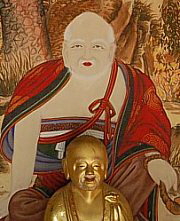
Dokseong, Gapsa Temple
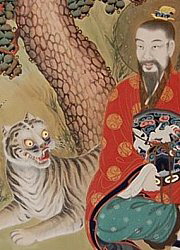
Mountain Spirit, who governs material wealth and is accompanied by a tiger.
Modern painting, Seokjongsa Temple.
|
|
Three spirits are worshiped widely in Korea. (1) Mountain Spirit, who governs material wealth and is accompanied by a tiger; (2) Lord of the Seven Stars, or Big Dipper, who governs human fortune and longevity; and (3) Dokseong, an enlightened hermit (solitary spirit) who blesses the people and brings sentient beings happiness during the age of decadence. The three also represent (1) Shamanism, (2) Taoism, and (3) Buddhism respectively.
As for Dokseong (C = Dúshèng 獨聖, K = Dokseong 독성, J = Dokushō), the Digital Dictionary of Buddhism (sign in with user name = guest) says this: "Hermit sage. [Korea] The hermit is an arhat 那畔尊者 (the Honored One Naban), who is said to have attained enlightenment on Tiantai Mountain 天台山. Syn. 獨修聖. See also 獨聖閣 and 那般尊者. [O. B. Chun]"
As for the tiger, it is one of four spiritual creatures (C = Sì Shòu 四獸), each guarding a direction on the compass in old China. The tiger corresponds to the direction WEST, the season fall, the color white, wind, the element metal, and the virtue righteousness. Japan's Nihon Shoki describes a Korean monk named Tokushi from Goguryeo, who is said to have learned agricultural techniques and the art of accupuncture from a "tiger" (this event is situated in Kōgyoku 4 [645 CE])
Says Bernhard Scheid on the PMJS list: "Being anything but an expert of ancient Korean history I only know of the myth that the semi-god Hwanung who chose among a tiger (woman) and a bear (woman), eventually deciding for the bear. The child of this couple was Dangun, the mythical ancestor of all Koreans. Obviously the legend was recorded much later than the Ryoiki (early 9th c.) but if we assume an ancient origin, it may provide a certain clue to the question, who "tigers" in ancient Korea could be, namely a neighboring, but propably "primitive" population (or perhaps the people from Silla from a Koguryeo/Baekje perspective?)"
Says Lin Pei-Ying on the PMJS list: "Those four-legged animals certainly bring vitality in monastic paintings! John Carpenter gave a presentation, "The Tiger in Zen Painting and Calligraphy" at the study day that Radu menioned. The tiger feature in religious contexts dating rather early; at least in the late sixth century, Chinese Daoist figure Zhang Daoling is dipicted with a tiger, and the tame tiger is compared to a dog in a Daoist biography. In some ninth- and tenth- century Dunguang manuscripts, a mysterious arhat-figure termed a tiger-tamer 伏虎 occured. About the same time, the Zen tradition in China also acquired a tiger-keeper, the monk Fenggan. (See T. H. Barrett, in J. Benn, L. Meeks & J. Robson, eds., Buddhist Monasticism in East Asia, 2005. pp. 115-6.)" |
|
|
|
|
|
|
|
|
|
|
Four Heavenly Kings
|
|
|
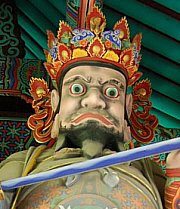
Virūḍhaka 增長天, guardian of the south, Gapsa Temple, S. Korea
|
|
Four Heavenly Kings 四天王 (C = sì tiānwáng, K = sa cheonwang 사천왕, J = shitennō). Buddhist guardians / protectors of the four compass directions. They ward off evil, guard the nation, and protect the world from malicious spirits. Each represents a direction, season, color, virtue, and element. They originated in India as deva generals protecting Lord Indra, but were later adopted into the Buddhist pantheon in China, Korea, and Japan. Each dwells in and protects one of the four continents surrounding Mt. Sumeru, the mythical home of the Historical Buddha and other Buddhist deities. In China, Korea, and Japan, they are venerated as temple guardians and protectors of the nation. In China and Korea, statues of the four are often placed near temple entrances, but in Japan, effigies of the four are more commonly placed around the central deity on the main altar (the main dais is befittingly called, in Japanese, the Shumidan 須弥壇).
LEARN MORE: Four Heavenly Kings (A-to-Z Dictionary) |
|
|
|
|
|
|
|
|
|
|
Kṣitigarbha Bodhisattva
|
Kṣitigarbha (C = Dìzàng 地蔵, K = Jijang 지장, J = Jizō) works to ease the suffering and shorten the sentence of those serving time in hell, to deliver the faithful into Amida's western paradise (where inhabitants are no longer trapped in the six states of desire and karmic rebirth), and to answer the prayers of the living for health, success, children, and all manner of mundane petitions. More popular in Japan than in China or Korea, but the many images I saw of Kṣitigarbh during this trip suggest that his cult is quite strong in Korea. Kṣitigarbha came to prominence in 7th-to-9th century China, then spread to Korea and Japan. From the beginning, he was associated with souls suffering in the underworld, thus his imagery in Korea and Japan is also closely associated with the afterlife. Yet, in Japan, Kṣitigarbha (J = Jizō) was conflated-integrated with local kami cults and is perhaps today one of Japan's most beloved deities. In modern Japan, Jizō is popularly venerated as the guardian of unborn, aborted, miscarried, and stillborn babies (Mizuko Jizō). These roles were not assigned to Jizō in earlier Buddhist traditions from mainland Asia; they are instead modern adaptations unique to Japan. At the same time, Jizō serves his/her customary and traditional roles as patron saint of expectant mothers, women in labor, children, firemen, travelers, pilgrims, and the protector of all beings caught in the six realms of transmigration. In the photo at right, the icons are dedicated to Kṣitigarbha as the deity of children. Elsewhere (see Vajra Deva below), he appears in the Hall of Judgment surrounded by Ten Kings of Hell & the Vajra Deva.
LEARN: Jizō (A-to-Z) || Jizō Rocks (Green Shinto) || Face of Jizō |
|
|
|
|
|
|
|
|
|
|
Vajra Deva or Vajrāpani
|
Vajra Deva or Vajrāpani, the "thunderbolt holder" (C = Rénwáng 仁王, K = Inwang 인왕, J = Niō). Sometimes translated as "benevolent kings" or "humane kings," a pair of Vajra Deva commonly stand guard outside the temple gate in China, Korea, and Japan, one on either side of the entrance.
The Vajra Deva are Hindu gods incorporated into Buddhism as protectors against evil spirits. If you look at their mouths, you will typically notice that one has its mouth open and the other has its mouth closed, said to represent life and death, the beginning and the end, from alpha to omega. Their fierce and threatening appearance is said to ward off evil spirits and keep the temple grounds free of demons and thieves. In some accounts, they were said to have followed and protected the Historical Buddha when he traveled throughout India.
LEARN MORE: Niō (A-to-Z Dictionary) |
|
|
|
|
|
|
|
|
|
|
Other Deities in Above Slide Show
|
- Medicine Buddha. Sanskrit = Bhaiṣajya-guru, C = Yàoshī 藥師, K = Yaksa 약사, J = Yakushi.
- Bodhisattva of Wisdom. S = Mañjuśrī, C = Wén Shū 文殊, K = Munsu 문수, J = Monju.
- Bodhisattva of Pratice. S = Samantabhadra, C = Pǔxián 普賢, K = Bohyeon 보현보살, J = Fugen.
|
|